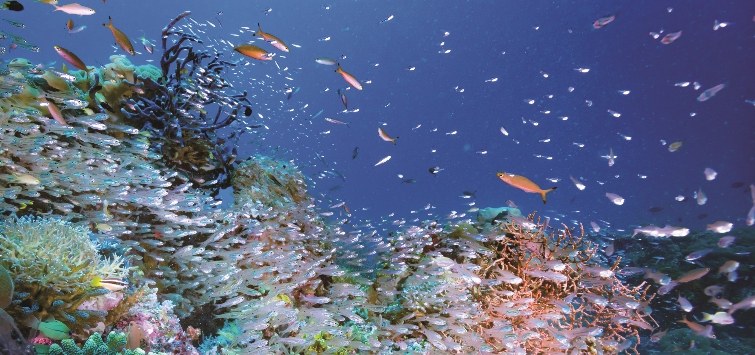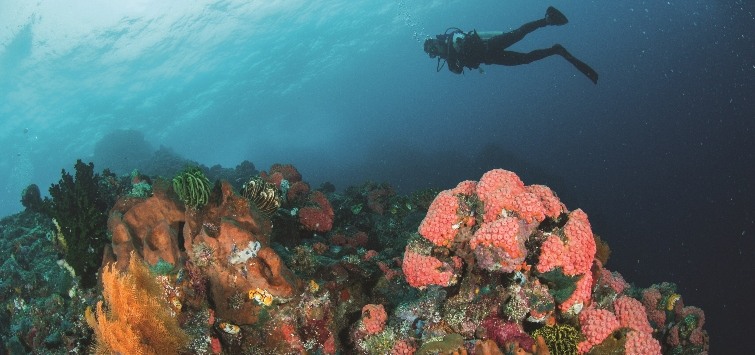The Reefs of West Papua: Exploring Fish from Indonesia
Author: Francesco Ricciardi
The waters and forests of the Indonesian province of West Papua are home to a vast multitude of species, most of them yet to be officially described. Seeing fish from Indonesia in West Papua is like a dive into the past, before the wave of extinctions and the biodiversity crisis many of the world’s reefs are experiencing today.
Imagine traveling back in time and diving in a remote area in the Indo-Pacific Ocean even just a few hundred years ago, before the appearance of so many humans and their fishing. Imagine more intact reefs and millions of tons of additional fishes in the sea, before the industrial revolution and the generations of burning fossil fuels that followed.
In this dive into the past, you would enter clear, warm water, a healthy ecosystem with flourishing hard and soft corals, among which swim a multitude of colorful fish hunted by big, fast predators day and night.
In the absence of a time machine, there is still a chance of having an underwater experience of a lifetime. You just need to travel to some very remote locations. Unfortunately, not many places are left that are almost untouched by human activities, but one of them sits between Oceania and Southeast Asia, an Indonesian province called West Papua.
Diving in West Papua
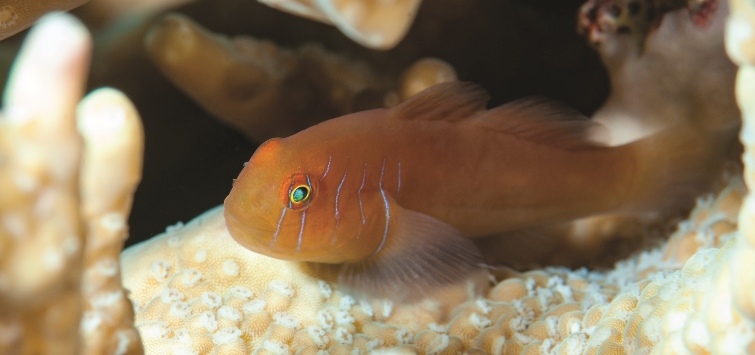
Five-lined coral goby (Gobiodon quinquestrigatus).
The area is still difficult to reach. The biggest city, Sorong, only has a domestic airport and mostly features small villages of fishermen and farmers. West Papua is an astonishingly rich mix of reefs and rainforests, though, with some of the most beautiful environments on the planet, and it is home to incredible biodiversity. It is in the heart of the Coral Triangle, with its marine ecosystems hosting more than 1,700 fish species (and counting) and 75 percent of the world’s hard coral diversity.
There are single reefs in West Papua that host more species than the entire Caribbean. Various theories seek to explain the reason for this astonishing biological diversity. The most reliable is based on the long-term geological stability of the region and the large number of microhabitats, including sheltered lagoons, deep reefs, mangroves, coastal swamps, and islands, that prompted life to become so differentiated, a phenomenon called “speciation.”
In recent times, the relatively low local population density has helped to maintain marine and terrestrial ecosystems here in a nearly pristine state. The gateway to Raja Ampat, where most of the liveaboard cruises head to and an archipelago comprising over 1,500 islands surrounding the four main islands of Misool, Salawati, Batanta, and Waigeo (the “Four Kings”), is the port of Waisai, connected to Sorong via a ferry terminal and a trip of approximately four hours.
The relative isolation of the area and the difficulties of finding supplies (not only food and water, but even fuel for the boats) has kept it very expensive to visit compared to other regions of Indonesia. Along with difficult flight logistics, costly taxi fares in Sorong, and few choices for hotel accommodations, mass tourism is not popular. However, if you manage to deal with these inconveniences and finally get to West Papua, what you will experience will pay you back, with interest.
From Apex Predators to Pygmy Gobies
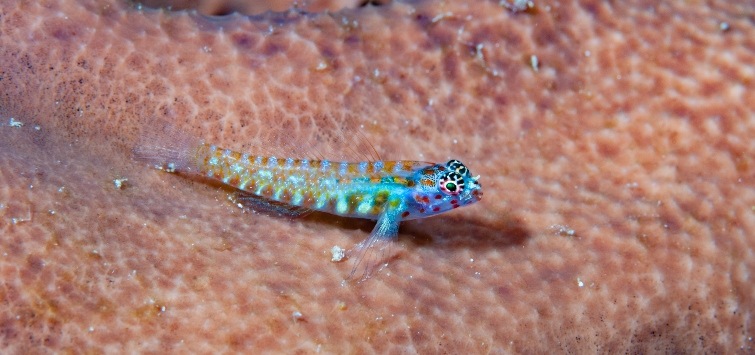
A red-spotted pygmy goby (Eviota albolineata) encountered off the Indonesian province of West Papua.
The abundance of large animals, including top predators like sharks and groupers, and pacific giants like oceanic manta rays, probably has no equal in Southeast Asia. Whitetip and blacktip reef sharks are common, especially at dawn and in deeper reefs. Gray reef sharks appear in groups of several individuals along drop-offs of fringing reefs and in calm lagoons during their juvenile stages. Well-camouflaged Wobbegong sharks (at least two species live in the area) and the nocturnal “walking shark” (Hemiscyllium halmahera), so named because of its ability to “walk” on the seafloor using its pectoral fins (discovered a few years ago by a team of marine biologists from the organization Conservation International) are very active in the area.Shark fins are considered a delicacy in the Chinese market, and shark fisheries have caused dramatic overfishing of almost every shark species in such excess that many countries have declared “shark finning” (the practice of cutting the fins from the shark and dumping the body of the still often alive animal back in the sea) illegal.
Some species have been included in the Convention on International Trade in Endangered Species of Wild Fauna and Flora (CITES), mostly in the Appendix II, which includes species that are not necessarily threatened with extinction, but for which trade must be controlled to avoid utilization incompatible with their survival. Of course it’s not enough, and illegal fishing is constantly an issue. The protection of West Papua waters from commercial fishing is vital to maintaining a safe shelter for large fish species, including sharks and manta rays, which are particularly abundant in Raja Ampat, at least in some seasons.
Giant oceanic manta rays (Manta birostris) and the smaller reef mantas (Manta alfredi) like waters rich in plankton, their only source of food. They also like to be cleaned and enjoy the free service of small fish, usually wrasses and bannerfishes, that remove parasites from their skin and gills. These “cleaner fish” have a very important ecological function, as fishes don’t have any way to remove parasites by themselves (except by risking injury to their skin by scratching on rocks and corals), so they are kept in very high regard, with no predators harassing them.
There are a few “cleaning stations” where it’s easier to find manta rays during the right season, and this is where most scuba divers go. To avoid disturbing the animals and overcrowding the dive sites, the local communities have rangers patrolling the West Papua diving areas, especially the manta ray cleaning stations, to make sure that scuba divers behave appropriately, not getting too close to the cleaning stations.
The Reefs of West Papua
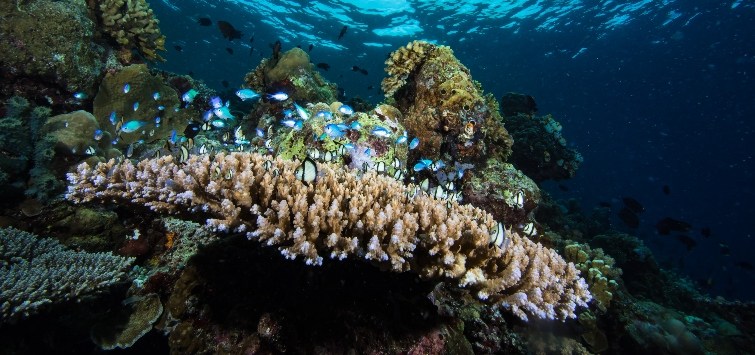
A table coral (Acropora sp.) serves as home base for several species of damselfish.
As far as fishing encounters, coral reefs in West Papua host almost every known ichthyological group. Just below sharks in terms of size, jackfish or trevallies, barracudas, and bigeyes are very common on shallow reefs, where they spend the days in large groups in mid-water, then actively hunt the reef when the sun goes down. Even more abundant out in the blue, very large schools of fusiliers feast on the abundant plankton that also sustains manta rays and other plankton feeders (schools of anthias, damselfish, some species of triggerfish, etc.) and the benthic filter feeders (from sponges to gorgonians and hard corals).
Every healthy coral reef has herbivores in large numbers, and West Papua is no exception to this rule. They are an important group in the food web, as they control algae proliferation that could threaten coral survival. Bumphead parrotfishes (Bolbometopon muricatum) are largely herbivores, mostly feeding on benthic algae, but also some live corals.
In many other regions, they are subject to intense overfishing, but they are precious, as they transform the corals they eat into a fine, white sand that contributes to beach formation. Other large schools of herbivores, such as surgeonfish, other parrotfish species, and rabbitfish help to limit algae growth and to maintain healthy equilibrium between corals and primary producers (algae and plants).
Every time I visit Raja Ampat, I return home with many photos of fish from Indonesia that I haven’t seen before, and I have spent about 5,000 hours underwater in my life, most of them trying to photograph fishes. This brings sleepless nights as I try to positively ID the fish in my reference books.
Conservation and New Discoveries
Community-based conservation is the key to keeping Raja Ampat, and West Papua in general, as pristine as it is now. Major threats are coming from unsustainable fishing (for example, cyanide and dynamite fishing and turtle egg collection), from mass tourism on the marine side, and from land degradation (for example, uncontrolled expansion of palm oil and rubber plantations, large-scale logging, and mining.)Community laws are based on the principles of Hak Adat and Sasi Laut, which detail the customary rights and taboos pertaining to locals and their natural resources. With the help of some international NGOs, local communities are working to preserve their environment for future generations to enjoy as well.
The region is heaven for taxonomists, who are using their discoveries not only for the sake of pure scientific research but also to push for more protection of the area, as some signs of dynamite fishing have been noticed and industrial fishing fleets are pushing to get access.
Every scientific expedition organized in West Papua tends to come back with several undescribed species. The last one I am aware of, after only two weeks in a remote island in Berau Bay, in the coastal district of Fakfak Island, came back with nine potential new species, including pygmy gobies, shrimp gobies, damselfishes, a wrasse, and a pipefish. How many other exciting underwater discoveries still await?
See the full article on TFH Digital
https://www.tfhdigital.com/tfh/mar_apr_2019/MobilePagedReplica.action?pm=2&folio=54#pg57

.png?h=595&iar=0&w=2781&hash=5FD5E69473BCC22199FBFA2FB71B6033)
